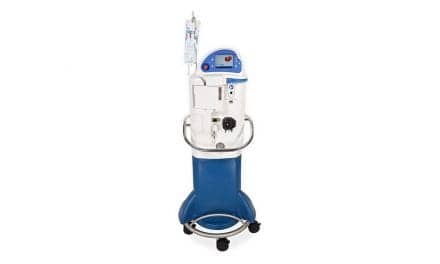The use of high-flow oxygen therapy delivered via high-flow nasal cannula is becoming more prevalent in hospitals, as clinicians search for viable and effective alternatives to more invasive, costlier treatments.
By Phyllis Hanlon
The use of nasal cannula therapy dates back to World War I when soldiers exposed to poisonous gas received oxygen through a small rubber catheter in the nasopharynx. By the 1920s, pediatric patients were receiving the therapy.1 In time, the design and composition materials of the delivery system changed. Most recently, high-flow, heated and humidified oxygen delivered by nasal cannula has become more prevalent in some hospital systems.

Heat & Humidity
Teleflex has been in the humidification business since the late 1970s, according to Kelli McGrew, MS, RRT, Respiratory Clinical Support and Education Manager. Scientific research, focus group input and “voice of the customer” surveys have resulted in products that address unmet needs. This combined data led to the development of a circuit that would allow for the delivery of high-flow, heated and humidified oxygen via cannula (HFNC) to a wide range of patients, from neonates to adults. With a range of cannula sizes and the option to adjust flow rates, this approach gives clinicians a versatile technology to treat all populations. For instance, for the infant in the neonatal intensive care unit (NICU), the flow rate may be 8 LPM, while an adult, depending on medical need, might receive as much as 60 LPM, she said.
McGrew shared that by using the Neptune Heated Humidifier with ConchaSmart Technology clinicians have the ability to set the temperature and deliver the optimal amount of humidity during HFNC through the new Comfort Flo Plus Cannula, based on patient needs and what is comfortable for the patient. “Again, this goes back to patient comfort and compliance with the therapy, which may have an impact on outcomes.”
As far as indications are concerned, HFNC has been found to be effective in patients with several different diagnoses, including acute hypoxemic respiratory failure, post-extubation support and other pulmonary conditions,2 noted McGrew. Clinicians may also use this approach with patients who have a Do Not Resuscitate/Do Not Intubate (DNR/DNI) order as an alternative to non-invasive ventilation.3 “[HFNC] is being used more and more, depending on the protocol of the facility.”

Patient Populations
Steve G. Peters, MD, division of Pulmonary and Critical Care Medicine at the Mayo Clinic, coauthored a 2013 study3 that supported the use of HFNC therapy in patients with several different diagnoses, eg, pulmonary fibrosis, pneumonia, chronic obstructive pulmonary disease (COPD), cancer, hematologic malignancy and CHF. “The underlying disease does not necessarily affect the decision to try high-flow nasal oxygen,” he said.
However, HFNC may not always work effectively in all patients. “Patients with conditions such as COPD might have CO2 retention that would steer a clinician toward the early use of noninvasive ventilation,” said Peters. “NIV or intubation and mechanical support would typically be considered for persistent signs and symptoms of respiratory failure despite high flow oxygen, including labored breathing, tachypnea, tachycardia and persistent oxygen desaturation.”
In this study, subjects were treated in the ICU, where therapy is initiated “because of the potential need for frequent assessments by respiratory therapists, nursing staff and physicians,” according to Peters. “The duration of use depends upon the response and the overall prognosis of the patient’s medical conditions. Once stable settings are established, there are many advantages to being out of the ICU environment, including patient comfort, staffing requirements and cost.”
In the two years since publication of this study, the use of HFNC has continued to increase as familiarity and recognition of the potential benefits have increased, according to Peters.
In response to Peters’ study, Richard B. Wettstein, MMEd, RRT, Department of Respiratory Care, University of Texas Health Science Center, San Antonio, noted that HFNC therapy “not only provides oxygen therapy similar to other simple oxygen equipment, but it also provides a low level of CPAP,” making HFNC a “crossover strategy.”4 He added that the benefits of using HFNC, such as increased patient comfort and compliance and low cost, outweigh those realized from traditional noninvasive CPAP devices and “might free up ICU beds for patients requiring more invasive interventions.”
Reduced Mortality Rates
In addition to better patient comfort and compliance, other studies have found a reduction in mortality rates. Investigators in Europe published a study5 in which they examined the use of HFNC in patients with acute hypoxemic respiratory failure at 23 ICUs in France and Belgium. Subjects were divided into three groups: the standard oxygen group received 10 LPM or more of oxygen therapy continuously through a nonrebreather facemask; subjects in the noninvasive ventilation group received pressure support in noninvasive ventilator mode through a facemask; and the high-flow oxygen group received 50 LPM through a heated humidifier continuously through binasal prongs.
The authors noted a decrease in respiratory discomfort and an improved dyspnea score one hour after enrollment in the high-flow nasal oxygen group when compared to the standard oxygen and noninvasive ventilation groups. According to the study, “High flow oxygen therapy, as compared with standard oxygen therapy or noninvasive ventilation, resulted in reduced mortality in the ICU and at 90 days.” The authors surmised that the findings might be attributed to the “heating and humidification of inspired gases, which prevented thick secretions and subsequent atelectasis but also from low levels of PEEP generated by a high gas flow rate and flushing of upper-airway dead space.”
Furthermore, the authors suggest that these findings may be generalized to patients admitted to the ICU without hypercapnic acute hypoxemic respiratory failure.
Supportive Evidence
Nicholas S. Hill, MD, FCCP, division of Pulmonary, Critical Care and Sleep Medicine, Tufts Medical Center, and colleagues sought to understand the mechanisms of action and clinical implications of using heated, humidified high-flow nasal oxygen in an adult population. In a 2015 study6 the authors explained that HFNC systems typically do not permit entrainment of room air during inspiration. “High flow is sufficient to keep up with inhalations of any dyspneic patient. The patient gets to inhale air closer to FiO2,” he said, “but this may change if the patient is breathing with an open or closed mouth.”
In this paper, Hill and colleagues had indicated that HFNC “was less well tolerated than conventional oxygen therapy in the postextubation period after cardiac surgery.” However, he pointed out that the article he coauthored was written in July 2015; since that time other studies have yielded dissimilar findings. “Today, I’d have a different story. [Recent research] indicates that high-flow is pretty well tolerated in post-surgical patients,” he said.
Additionally, in his paper Hill asserted, “more work is needed to determine how to best select candidates and make adjustments [for airflow, levels of heat and humidity] to optimize comfort. In the past year and a half approximately six high quality, well-designed studies have provided good evidence that HFNC “has a place” in the treatment of patients with hypoxemic respiratory failure, according to Hill. “[This therapy] is best used in patients with significant oxygen needs. HFNC can adjust the FiO2 to 100% or anything in between,” he said. “Other studies suggested that high flow is as good as and more comfortable than noninvasive ventilation. Noninvasive ventilation is not very comfortable. Patient can’t tolerate it for long, only a couple of hours or so. High-flow is well tolerated so patients may use it for several days.”
Careful Monitoring
While high-flow oxygen therapy is gaining ground, Hill advised clinicians to carefully determine the most appropriate therapy, based on patient condition to avoid complications. “You need to be cautious. If you can adequately oxygenate with standard oxygen, that’s what you should do,” he said. Furthermore, decreasing oxygenation levels in the patient might indicate the need to switch to a more invasive therapy. “You get into more trouble if you delay intubation. You run the risk of emergency intubation or arrest,” he said.
Prior to initiating HFNC, Hill suggested clinicians obtain an arterial blood gas reading and utilize pulse oximetry to determine the most appropriate temperature and flow for the patient. In a hypercapnic patient, Hill recommended checking CO2 levels every half hour or more until the patient is stabilized. “If oxygenation is better and stable, the target saturation might not need to be observed as frequently. For people on HFNC a number of hours or days, you could check every few hours. These patients would be on a monitor and the alarm would be set to trigger if the saturation dropped,” he said.
Alternate Settings
In many cases, HFNC therapy has been used primarily in the ICU, but Hill suggested it might also be a viable option in intermediate care. He explained that there is a learning curve, but the therapy is relatively simple to master. Floor staff trained in HFNC administration would be capable of continuing the treatment once the patient is moved from the ICU. However, the decision to use HFNC on the floor depends on a couple of factors. How closely does the patient need to be monitored, Hill asked. To verify if a patient is ready to move out of the ICU and onto the floor with HFNC, Hill considers if a crisis would occur if the nasal cannula fell out. “If the patient has no problem with oxygenation for a day and is comfortable with the acute process treatment, he could move to the floor. When I’m satisfied with the respiration, this is the criteria I use for moving the patient to the floor,” he said. “Initially, HFNC was only done in the ICU.”
Hill suggested that certain floors/units be designated as appropriate for patients with HFNC. “Staff should be in-serviced and experienced in monitoring patients. You have to think through what kind of patient and staff training is necessary,” he said.
As a rapidly evolving field, more and more studies are providing updates on the benefits of using high-flow nasal cannula therapy.
RT
Phyllis Hanlon is a contributing writer to RT. For further information, contact [email protected].
References
- Ward JJ. “High-flow oxygen administration by nasal cannula for adult and perinatal patients.” Respir Care. January 2013;58(1):98-122.
- Scala R. “High-flow nasal oxygen therapy: one more chance for extubation?” Respir Care. April 2014;59(4): 609-612.
- Peters SG, Holets SR, Gay PC. “High-flow nasal cannula therapy in do-not-intubate patients with hypoxemic respiratory distress.” Respir Care. April 2013; 58(4):597-600.
- Wettstein, RB. “A fresh look at the physiologic effects of high-flow nasal cannulae and the role they play in patient care.” Respir Care. 2013;58(4):715-716.
- Frat JP, Thille AW, Mercat A et al. “High-flow oxygen through nasal cannula in acute hypoxemic respiratory failure.” N Engl J Med. June 2015; 372(23):2185-2196.
- Spoletini G, Alotaibi M, Blasi F, Hill NS. “Heated humidified high-flow nasal oxygen in adults.” CHEST. July 2015;148(1):253-261. doi: 10.1378/chest.14-2871.
- Kotecha S, et al. “Safety and efficacy of high-flow nasal cannula therapy in preterm infants: a meta-analysis.” Ped. Sep 2015; 136(3). http://dx.doi.org/10.1542/peds.2015-0738










